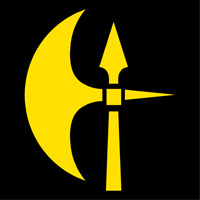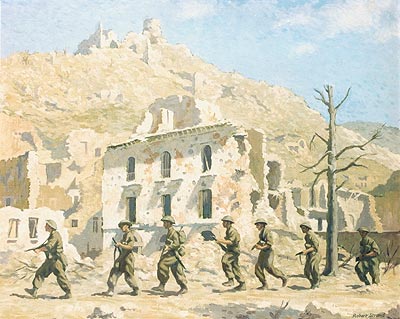 East Surreys in the Second World War
East Surreys in the Second World War
The East Surrey Regiment in the 1939-1945 War
The Campaign in France in 1940
Between the Wars the 1st Battalion served in Egypt, Hong Kong, India and the Sudan from 1920 to 1938. The 2nd Battalion meanwhile served in Turkey, Ireland, Gibraltar and Shanghai. The Territorial Battalions were resuscitated in 1921. At the outbreak of the Second World War three battalions of The East Surrey Regiment, the 1st, 1/6th and 2/6th served in France with the British Expeditionary Force. In May 1940, the 1st and 1/6th advanced into Belgium but were driven back by the force of the German Blitzkrieg. The line of the River Escaut was held temporarily, but a fighting withdrawal to the coast became inevitable. On their last night in Belgium, the 1st Battalion was ordered to Nieuport to counter-attack in the 1/6th Surreys area. The counter-attack stabilised the situation, and side by side with the 1/6th, they held the position until ordered to withdraw to the beaches prior to embarkation. On 1st June 1940 the two weary East Surrey Battalions, led by their fine Commanding officers, Lieutenant Colonels Boxshall and Armstrong, marched the 12 miles along the sands to Dunkirk. So ended their 1940 Campaign.
The recently-formed 2/6th Surreys landed in France in April 1940, initially intended for duties on the lines of communication. However, they were caught up in the battle for the Channel ports, and were ordered to take up a defensive position on the River Béthune, as part of the Support Group of the 1st Armoured Division. In spite of valiant resistance, the Battalion was driven back to the coast, and was forced to surrender at St Valery on 12th June 1940.
 |
2nd Battalion in Malaya and formation of The British Battalion
An even worse disaster was the loss of the 2nd Bn The East Surrey Regiment in Singapore. The Japanese invaded Malaya on 7th December 1941, and the Battalion was heavily involved in the fighting all the way down the peninsula. At the Battle of Gurun a week later, Battalion Headquarters was overrun and the Commanding Officer, Major Dowling, killed, as were two company commanders and a large number of officers and men. They had suffered such heavy casualties by 20th December that the 2nd Bn The East Surrey Regiment was amalgamated with the 1st Bn The Leicestershire Regiment, and fought the remainder of the campaign as ‘The British Battalion’. Eventually, after many delaying actions, the British Army was forced into Singapore Island, and there, on 15th February 1942, compelled to surrender.
Of the 2nd Battalion’s 786 men who met the Japanese in December 1941, only 265 remained. Of these, a further 149 were to die while prisoners of war of the Japanese. Although the 2nd Surreys had ceased to exist as a fighting unit, their Colours, the symbol of the spirit of the Regiment, never fell into enemy hands. They had been deposited in the vaults of a bank in Singapore in 1940, and were recovered intact five years later. These fine old Colours, with their distinctive black facings, which had been presented to the 70th Regiment in 1864, can be seen in the Regimental Museum.

The 1st and 1/6th Battalions in North Africa
The 1st Battalion, now in the 78th Division, returned to active operations in the Allied landings in North Africa in November 1942, and advanced rapidly to within 18 miles of Tunis. Here it was held up after heavy casualties, and forced to withdraw. For six weary months, during which the 1/6th Battalion in the 4th Division joined the First Army, they fought in the mountains of Northern Tunisia against some of the best divisions in Von Arnim’s Army. Casualties were heavy in the two Surrey battalions, and each lost its Commanding Officer. Lt Colonel Bruno of the 1/6th was killed leading his men in an attack on a strongpoint. Lt Colonel Wilberforce died on the eve of victory, killed by the last shell to be fired into the 1st Battalion area. After the link-up between the 1st and 8th Armies, and the final co-ordinated attack, the Germans surrendered on 12th May 1943, and the North African Campaign was over.
 |
 |
|
| 78th Div | 4th Infantry Div |
1st and 1/6th Battalions in Sicily and Italy
Two months later, the 1st Battalion was again in action, this time in the mountains of Sicily. This was a short but difficult campaign with 78 Division operating on the lower slopes of Mount Etna. Every yard had to be fought for, but by mid-August 1943 the Germans had withdrawn to the mainland, and the Sicilian campaign was over.

Then followed the campaign on the mainland of Italy from September 1943 to May 1945. The Allies were confronted with a long, mountainous peninsula, all the rivers of which flowed east and west, conferring an invaluable advantage on the defender. It was a long, slow advance of heavy and costly fighting - very much an infantryman’s war. The 1st Battalion, still in 78 Division, landed in Italy in September 1943 and the 1/6th five months later. The 1st Battalion advanced slowly against strong opposition and in severe winter weather. One of the principal battles was that for a bridgehead across the River Sangro.

1/6 Surreys with the monastry in the background.
Both Battalions were involved in the battles for Cassino, which was the key to the advance northwards to Rome in 1944. The 1/6th, particularly, had much hard fighting in the crossing of the Rapido River, south of Cassino. Here their second Commanding officer, Lt Colonel Thompson, was killed in action. The battle honour ‘Cassino’ was awarded for these operations. After the fall of Rome on 4th June 1944, two days before the Allied invasion of Europe, there was still much hard fighting ahead, most of it in the mountains. The 1st Battalion’s final battle, in April 1945, was for Argenta, part of the main line of the German defence south of the River Po. The 1/6th had been withdrawn from Italy after the capture of Forli in November 1944, and transferred to operations in Greece.

Related
